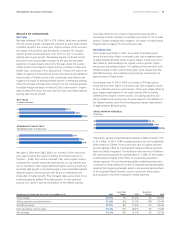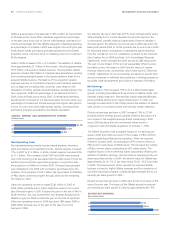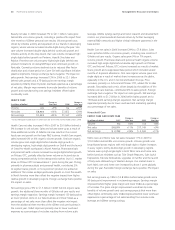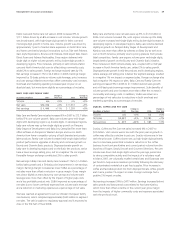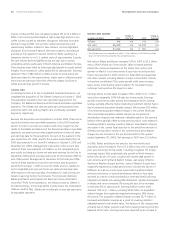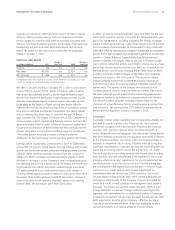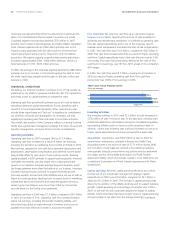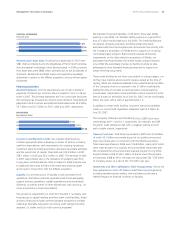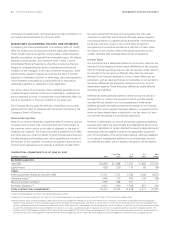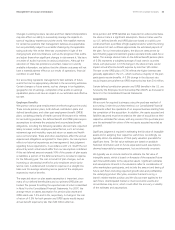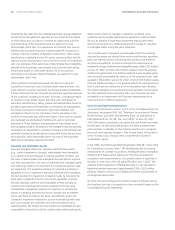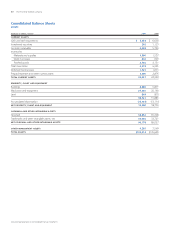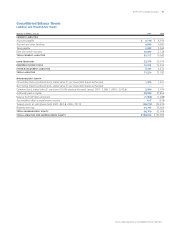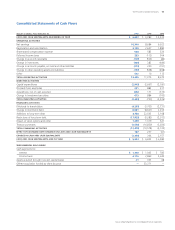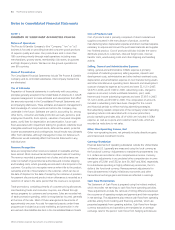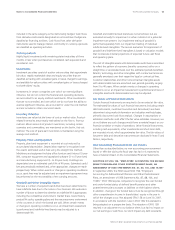Proctor and Gamble 2007 Annual Report Download - page 47
Download and view the complete annual report
Please find page 47 of the 2007 Proctor and Gamble annual report below. You can navigate through the pages in the report by either clicking on the pages listed below, or by using the keyword search tool below to find specific information within the annual report.The Procter & Gamble Company 45Management’s Discussion and Analysis
Changes in existing tax laws, tax rates and their related interpretations
may also affect our ability to successfully manage the impacts on
taxes of regulatory matters around the world. We establish reserves
for certain tax positions that management believes are supportable,
but are potentially subject to successful challenge by the applicable
taxing authority. We review these tax uncertainties in light of the
changing facts and circumstances, such as the progress of tax audits,
and adjust them when signicant changes in risk warrant it. We have
a number of audits in process in various jurisdictions. Although the
resolution of these tax positions is uncertain, based on currently
available information, we believe that the ultimate outcomes will not
have a material adverse effect on our results of operations, nancial
condition or cash ows.
Our accounting represents management’s best estimate of future
events that can be appropriately reected in the accounting estimates.
Certain changes or future events, such as changes in tax legislation,
geographic mix of earnings, completion of tax audits or earnings
repatriation plans could have an impact on our estimates and effective
tax rate.
We sponsor various post-employment benets throughout the world.
These include pension plans, both dened contribution plans and
dened benet plans, and other post-employment benet (OPEB)
plans, consisting primarily of health care and life insurance for retirees.
For accounting purposes, the dened benet and OPEB plans require
assumptions to estimate the projected and accumulated benet
obligations, including the following variables: discount rate; expected
salary increases; certain employee-related factors, such as turnover,
retirement age and mortality; expected return on assets and health
care cost trend rates. These and other assumptions affect the annual
expense and obligations recognized for these plans. Our assumptions
reect our historical experiences and management’s best judgment
regarding future expectations. In accordance with U.S. GAAP, the net
amount by which actual results differ from our assumptions is deferred.
If this net deferred amount exceeds 10% of the greater of plan assets
or liabilities, a portion of the deferred amount is included in expense
for the following year. The cost or benet of plan changes, such as
increasing or decreasing benets for prior employee service (prior
service cost), is deferred and included in expense on a straight-line
basis over the average remaining service period of the employees
expected to receive benets.
The expected return on plan assets assumption is important, since
many of our dened benet plans and our primary OPEB plan are
funded. The process for setting the expected rates of return is described
in Note 9 to the Consolidated Financial Statements. For 2007, the
average return on assets assumption for pension plan assets and
OPEB assets was 7.2% and 9.3%, respectively. A change in the rate
of return of 0.5% for both pension and OPEB assets would impact
annual benet expense by less than $40 million after tax.
Since pension and OPEB liabilities are measured on a discounted basis,
the discount rate is a signicant assumption. Discount rates used for
our U.S. dened benet and OPEB plans are based on a yield curve
constructed from a portfolio of high quality bonds for which the timing
and amount of cash outows approximate the estimated payouts of
the plan. For our international plans, the discount rates are set by
benchmarking against investment grade corporate bonds rated AA or
better. The average discount rate on the dened benet pension plans
of 5.5% represents a weighted average of local rates in countries
where such plans exist. A 0.5% change in the discount rate would
impact annual after-tax benet expense by less than $45 million.
The rate on the OPEB plan of 6.3% reects the higher interest rates
generally applicable in the U.S., which is where a majority of the plan
participants receive benets. A 0.5% change in the discount rate
would impact annual after-tax OPEB expense by less than $10 million.
Certain dened contribution pension and OPEB benets in the U.S. are
funded by the Employee Stock Ownership Plan (ESOP), as discussed in
Note 9 to the Consolidated Financial Statements.
We account for acquired businesses using the purchase method of
accounting. Under the purchase method, our Consolidated Financial
Statements reect the operations of an acquired business starting from
the completion of the acquisition. In addition, the assets acquired and
liabilities assumed must be recorded at the date of acquisition at their
respective estimated fair values, with any excess of the purchase price
over the estimated fair values of the net assets acquired recorded as
goodwill.
Signicant judgment is required in estimating the fair value of intangible
assets and in assigning their respective useful lives. Accordingly, we
typically obtain the assistance of third-party valuation specialists for
signicant items. The fair value estimates are based on available
historical information and on future expectations and assumptions
deemed reasonable by management, but are inherently uncertain.
We typically use an income method to estimate the fair value of
intangible assets, which is based on forecasts of the expected future
cash ows attributable to the respective assets. Signicant estimates
and assumptions inherent in the valuations reect a consideration of
other marketplace participants, and include the amount and timing of
future cash ows (including expected growth rates and protability),
the underlying product life cycles, economic barriers to entry, a
brand’s relative market position and the discount rate applied to the
cash ows. Unanticipated market or macroeconomic events and
circumstances may occur, which could affect the accuracy or validity
of the estimates and assumptions.


